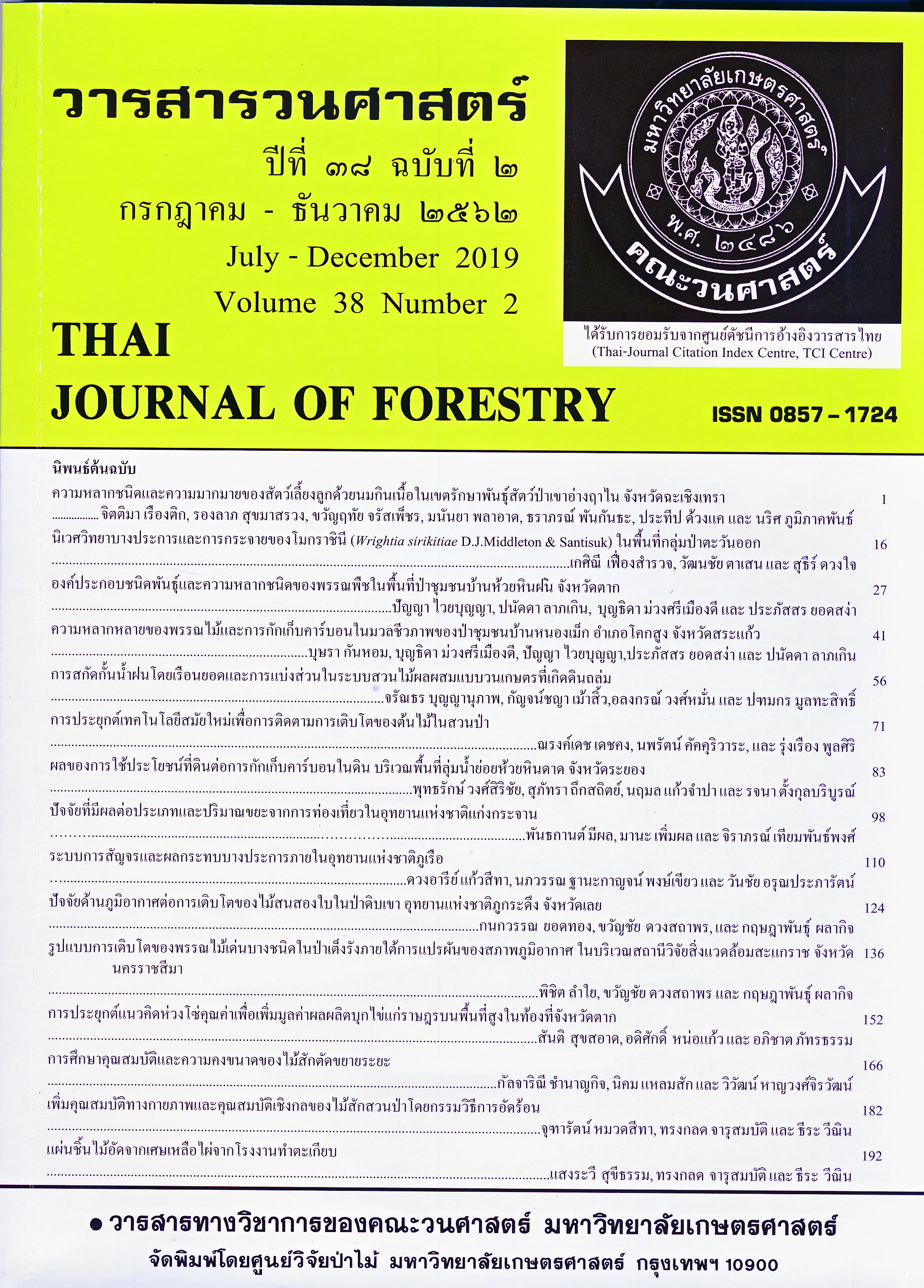ปัจจัยที่มีผลต่อประเภทและปริมาณขยะจากการท่องเที่ยวในอุทยานแห่งชาติแก่งกระจาน
Main Article Content
บทคัดย่อ
ปัญหาขยะในแหล่งท่องเที่ยวทางธรรมชาติมีแนวโน้มเพิ่มขึ้นส่งผลต่อความสมบูรณ์ของระบบนิเวศและประสบการณ์ท่องเที่ยว งานวิจัยนี้ศึกษาประเภท ปริมาณและปัจจัยที่ส่งผลต่อปริมาณขยะในอุทยานแห่งชาติแก่งกระจาน เก็บข้อมูลระหว่างเดือนกรกฎาคม – ธันวาคม พ.ศ. 2561 ครอบคลุมฤดูเปิดและปิดการท่องเที่ยว ประเภทวัน ในที่ทิ้งขยะของบ้านกร่าง ด่านเขาสามยอด และที่ทำการอุทยานแห่งชาติฯ พบว่า นักท่องเที่ยวเป็นแหล่งกำเนิดขยะที่สำคัญที่สุด มีการรวบรวมขยะในระดับดี แต่ควรปรับปรุงการคัดแยกขยะของด่านสามยอด และการกำจัดขยะโดยเฉพาะเศษอาหารในทุกพื้นที่ เพราะพบสัตว์ป่าที่ใช้พื้นที่ทิ้งขยะอย่างน้อย 36 ชนิด ผลการศึกษายังพบมีขยะเกิดขึ้นในอุทยานแห่งชาติแก่งกระจานเฉลี่ย 38.10±8.15 กิโลกรัม/วัน ส่วนใหญ่เป็นเศษอาหารร้อยละ 42.99 และเศษพลาสติก ร้อยละ 20.93 ส่วนขยะอื่นพบน้อยกว่าร้อยละ 10 ของขยะทั้งหมด นักท่องเที่ยวก่อให้เกิดขยะเฉลี่ย 0.43±0.18 กิโลกรัม/คน/วัน ปริมาณขยะทั้งหมด เศษอาหาร และพลาสติก มีความแตกต่างกันระหว่างประเภทวัน (p < 0.001) ฤดูเปิด-ปิดการท่องเที่ยว (p < 0.001) และพื้นที่ทิ้งขยะ (p < 0.001) จำนวนของนักท่องเที่ยวพักแรมและไป-กลับ มีอิทธิพลต่อปริมาณเศษอาหาร กระป๋อง แก้ว กระดาษทิชชู่และขยะทั้งหมดอย่างมีนัยสำคัญ (p < 0.001) ส่วนปริมาณขวดน้ำพลาสติก กระดาษและพลาสติก ได้รับอิทธิพลจากจำนวนของนักท่องเที่ยวพักแรมอย่างมีนัยสำคัญ (p < 0.001) อุทยานแห่งชาติแก่งกระจานต้องการแผนจัดการขยะที่เหมาะสมตามฤดูการท่องเที่ยว ประเภทวัน และพื้นที่ และควรลงทุนระบบจัดการขยะและส่งเสริมให้นักท่องเที่ยวคัดแยกและลดการสร้างขยะ เพื่อนำไปสู่การเป็นอุทยานแห่งชาติสีเขียว
Downloads
Article Details
ข้าพเจ้าและผู้เขียนร่วม (ถ้ามี) ขอรับรองว่า ต้นฉบับที่เสนอมานี้ยังไม่เคยได้รับการตีพิมพ์และไม่ได้อยู่ในระหว่างกระบวนการพิจารณาตีพิมพ์ลงในวารสารหรือสิ่งตีพิมพ์อื่นใด ข้าพเจ้าและผู้เขียนร่วม (ถ้ามี) ยอมรับหลักเกณฑ์และเงื่อนไขการพิจารณาต้นฉบับ ทั้งยินยอมให้กองบรรณาธิการมีสิทธิ์พิจารณาและตรวจแก้ต้นฉบับได้ตามที่เห็นสมควร พร้อมนี้ขอมอบลิขสิทธิ์ผลงานที่ได้รับการตีพิมพ์ให้แก่วารสารวนศาสตร์ คณะวนศาสตร์ มหาวิทยาลัยเกษตรศาสตร์ กรณีมีการฟ้องร้องเรื่องการละเมิดลิขสิทธิ์เกี่ยวกับภาพ กราฟ ข้อความส่วนใดส่วนหนึ่ง หรือ ข้อคิดเห็นที่ปรากฏในผลงาน ให้เป็นความรับผิดชอบของข้าพเจ้าและผู้เขียนร่วม (ถ้ามี) แต่เพียงฝ่ายเดียว และหากข้าพเจ้าและผู้เขียนร่วม (ถ้ามี) ประสงค์ถอนบทความในระหว่างกระบวนการพิจารณาของทางวารสาร ข้าพเจ้าและผู้เขียนร่วม (ถ้ามี) ยินดีรับผิดชอบค่าใช้จ่ายทั้งหมดที่เกิดขึ้นในกระบวนการพิจารณาบทความนั้น”
เอกสารอ้างอิง
Barnes, D.K.A., F. Galgani, R.C. Thompson and M.Barlaz. 2009. Accumulation and fragmentation of plastic debris in global environments. Philosophical Transactions of the Royal Society B. 364: 1985–1998.
Chairat, R. 2015. Wildlife Ecology and Management. 1st ed. Charansanitwong Printing Ltd., Bangkok. (in Thai)
Chatuworaphat, P. 2008. Solid Waste Management in National Park. Available Source: http://frc.forest.ku.ac.th/frcdatabase/bulletin/Document/C00623.pdf, February 23, 2019. (in Thai)
Department of National Parks, Wildlife and Plant Conservation (DNP). 2017. Kaeng Krachan National Park. Available Source: http://nps.dnp.go.th/parksdetail.php?id=130&name=อุทยานแห่งชาติแก่งกระจาน#, September19, 2017.
Gall, S.C. and R.C. Thompson. 2015. The impact of debris on marine life. Marine Pollution Bulletin 92: 170-179.
Hammitt, W.E., D.N. Cole and C.A. Monz. 2015. Wildland Recreation Ecology and Management. C. O. C. Printers Pte Ltd., Singapore.
Katlam, G., S. Prasad, M. Aggarwal and R. Kumar. 2018. Trash on the menu: patterns of animal visitation and foraging behaviour at garbage dumps. Current Science 115(12): 2322-2326.
Katsnelson, A. 2015. Microplastics present pollution puzzle. Proceedings of the National Academy of Sciences 112(18): 5547-5549.
Manfredi, E.C., B. Flury, G. Viviano, S. Thakuri, S.N. Khanal, P. K. Jha, R.K. Maskey, R.B. Kayastha, K.R. Kafle, S. Bhochhibhoya, N.P. Ghimire, B.B. Shrestha, G. Chaudhary, F. Giannino, F. Cartenì, S. Mazzoleni and F. Salerno. 2010. Solid waste and water quality management models for Sagarmatha National Park and buffer zone, Nepal. Mountain Research and Development 30(2): 127-142.
Pettingill, O.S. 1970. A Laboratory and Field Manual of Ornithology. Buress Publishing Company, Minnesota.
Phaibonsombut, P. 2003. Type, Quantity of Solid Waste, and Littering Behavior of Tourists and Entrepreneurs in Khao Yai National Park. M.S. Thesis, Kasetsart University. (in Thai)
Plaza, I.P. and S.A. Lambertucci. 2017. How are garbage dumps impacting vertebrate demography, health, and conservation? Global Ecology and Conservation 12: 9-20.
Pollution Control Department. 2004. A Complete Municipal Solid Waste Management: A Guideline for Local Administrative Office. 4th ed. Kurusapa Printing Ladphrao, Bangkok.
Puangthongkae, S. 2015. Types and Quantities of Solid Wastes from Tourism Activities, Lohdalam Beach, Koh Phi Phi Don. M.S. Thesis, Kasetsart University. (in Thai)
Subaru of America. 2019. Zero Landfill: from Becoming America’s First Zero-Landfill Automaker, with All Waste Recycled or Reused Our Current National Park Zero-Landfill Initiative. Available Source: https://www.subaru.com/csr/environment.html#!/2016/05/25, February 24, 2019.
Thompson, R.C., C.J. Moore, F.S. vom Saal and S.H. Swan. 2009. Plastics, the environment and human health: Current consensus and future trends. Philosophical Transactions of the Royal Society B 364(1526): 2153–2166.
Wagner, M. and S. Lambert. 2018. Freshwater Microplastics: Emerging Environmental Contaminants? The Handbook of Environmental Chemistry Volume 58. Springer, Nature, Switzerland.


